fxguide spoke to Franck Lambertz, Visual Effects Supervisor and Lead Flame artist at MPC LA, about their work on Washington’s Lottery spot. The Mini Market Musical final piece is both theatrical and engaging and literally turns the world upside down.
The production was shot on a combination of the Canon 5DMkII for the opening and 35mm film for the bluescreen material. The pipeline at MPC LA is set up for film work and thus commercial productions benefit by having the default workflow fully 2K just like for a feature film, even though the output final will be mastered at 1920 x1080. In this case the master was also output at 23.98 fps for 3:2 pulldown later.
” We are full 2k, we scan 2K…straight into Nuke, Shake or Flame…and grade 2K,” explains Lambertz.
“Just at the last minute we crop to HD which is great as it gives us the ability to zoom or reframe – I definitely love working this way,” he adds.
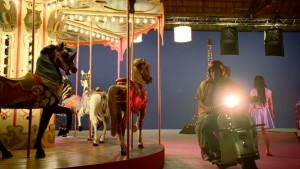
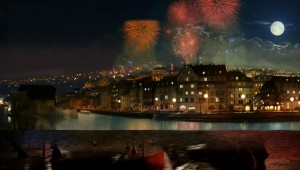
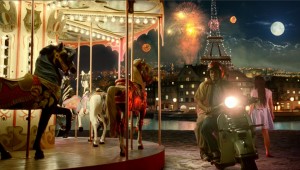
The Store
The director chose to film the opening on a 5D MkII to achieve a level of gritty reality far away from the beautiful, broadway show style main body of the spot. The initial shots, while looking 100% in camera, were themselves composites with a real convenience store in the background and a bluescreen small set piece in the foreground. Even simple shots of the actress in the store were all bluescreen shots. This allowed for the complex transition when the store magically breaks apart to reveal Paris in the spring, complete with fireworks and motorbikes. Paris was achieved with some beautiful matte painting work, again testament to the feature film level production values that MPC brought to the spot. This extended to include replacing the floor under the actress’s feet.
Watch an exclusive high res breakdown of the opening sceneUnderwater
One dramatic moment has the actress dive into a vertical refrigerator and end up in an underwater dance sequence. Initially the scene was designed as a bluescreen shoot, unfortunately on set a last minute Directorial decision led to a costume change into a blue dress, “which meant we had blue on blue.” While the keying clearly took longer, in Flame the tonal range and spill colours were at least working in MPC’s favor, even if the schedule was not. This entire sequence was completely done in Flame by Lambertz. “The environment could be fake but the director wanted the actress to look great…to look lovely and magical…for a 2D compositor it’s great, he (the director) opens up a new window of creativity.” Lambertz had worked with the director before and this led to a strong level of trust which was important as the spot required a stylized solution in most situations which MPC needed to invent and craft the look of no matter what 2D plate photography was shot.
For the underwater sequences, the actress never got wet but instead was shot on a trampoline in slow motion with fans to mimic the way the actress’s hair would move underwater. An effect complete by the addition of bubbles and fish.
The pipeline at MPC LA is set up for film work and thus commercial productions benefit by having the default workflow fully 2K just like for a feature film, even though the output final will be mastered at 1920 x1080. In this case the master was also output at 23.98 fps for 3:2 pulldown later.
” We are full 2k, we scan 2K…straight into Nuke, Shake or Flame…and grade 2K,” explains Lambertz.
“Just at the last minute we crop to HD which is great as it gives us the ability to zoom or reframe – I definitely love working this way,” he adds.
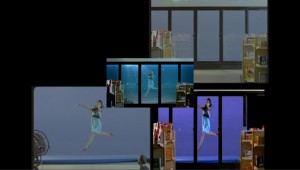
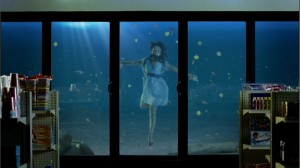
Transition
One shot presented real difficulty as the project’s leading lady was required to jump to the ceiling and dance on the ceiling tiles which in turn change to be a classic 1970’s flashing disco dance floor. In the pre-production meeting there was intended to be a cut between this scene and the preceding shot. Lambertz suggested making this one seamless transition where the world would spin and the actress would be tossed effortlessly onto the ceiling in one shot. Lambertz designed the shots and then in post built together the shot based on what the production could shoot in camera. The effect is complex as it requires the blending of multiple takes and an effective morph transition on the lead actress.
The shot was achieved by repeating the action right side up and then again with the actress’s male dancer assistants suspended on wires, coupled with a 180 degree camera rotation during all of which a morph not only blends the actress’s action but solves the difficult problem of her hair which clearly ends up at one stage incorrectly hanging.
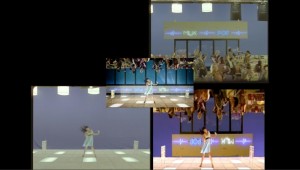
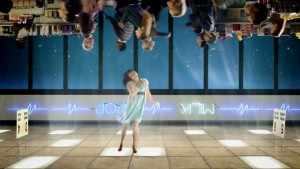
Disco Inferno
The dance sequence should have been relatively easy with a combination of the actress dancing on the fake lit ceiling tiles on bluescreen, over a cast of dancers and a background shop. Unfortunately for Lambertz and the team, the dress was still blue, and worse the floor tiles did not flash as the production wanted, so a new floor had to be rotoed in which really taxed the composite team as the now lit tiles would be unlit, but their light was still very visible on the actress’s legs.
Finally, the piece did come together and met the deadline. MPC had only three weeks in total for post-production after photography with just one Flame, one main Shake station with some additional Shake support and Smoke at the end for final conform and mastering. Much credit needs to go not only to the skill of Lambertz and the team, but also the MPC’s robust film level pipeline infrastructure that brings feature film approaches to TVC production.
Credits
Agency: Cole & Weber United
Client: Washington’s Lottery
Senior Art Director: Sunshine Stevens
Copywriter: Kevin Thomson
Producer: Jay Howard
Executive Producer: Pete Anderson
Project Manager: Andrea Franzen
Production Company: Directors Bureau
Director: Patrick Daughters
Director of Photography: Shawn Kim
Executive Producer: Melissa Culligan
Line Producer: Pete Vitale
Visual Effects House: MPC
Editing House: Final Cut
Editor: Stephen Berger
Composer: Grizzly Bear
Audio Mix: Play
Mixer: John Bolen
Choreographer: Michael Rooney
